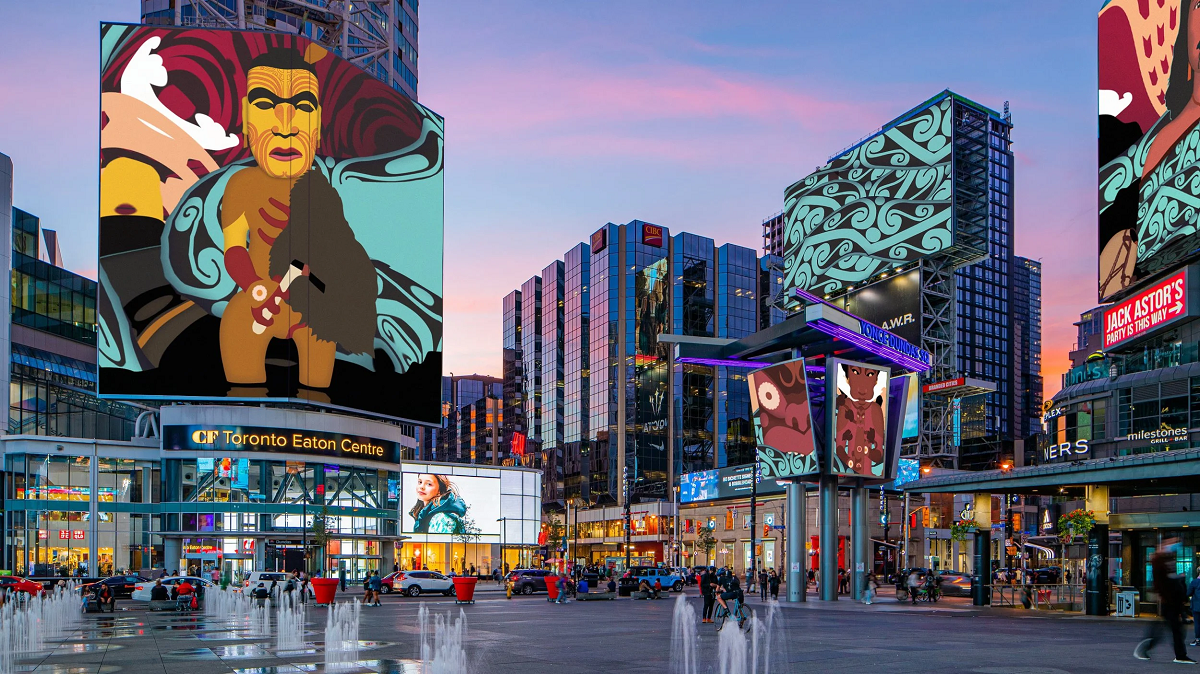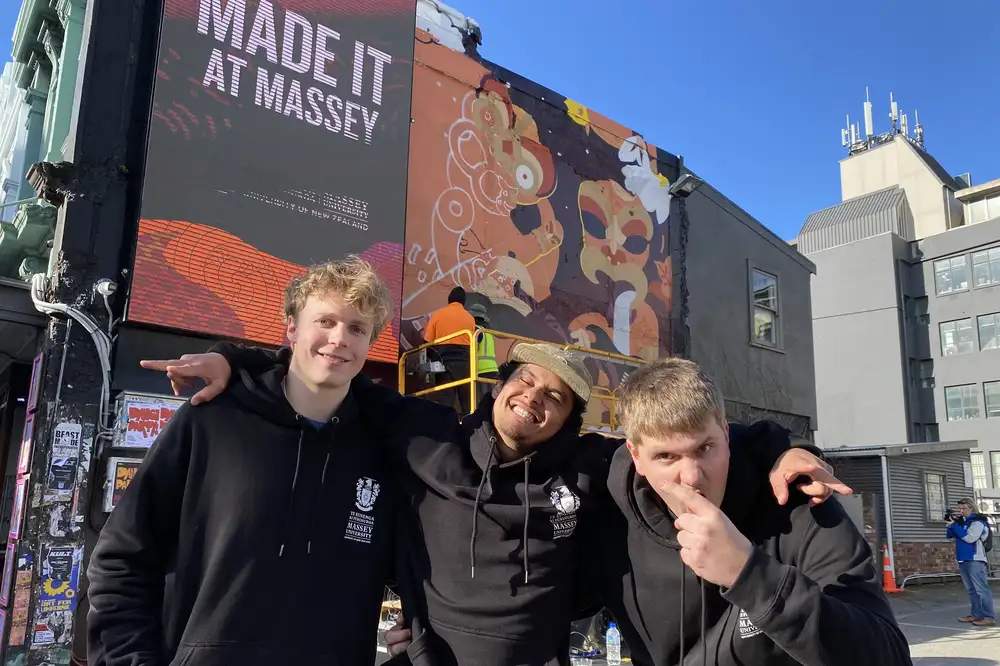Bridging Indigenous knowledge and creative technology
Professor Johnson Witehira (Tamahaki, Ngāi Tū-te-auru, Ngāti Hinekura) leads Toi Hangarau (Creative Technology) and heads Te Rewa o Puanga, the School of Music and Screen Arts, at Massey University. He blends Māori knowledge with today’s tools, designing Māori typefaces, creating large public artworks and digital works, and partnering with Māori communities across Aotearoa. Some of that work has even appeared in New York’s Times Square.
He is also a proud alumnus with a Doctor of Philosophy (Creative Arts). His thesis, “Tārai Kōrero Toi: Articulating a Māori Design Language,” laid the foundation for his career at the intersection of Indigenous knowledge and contemporary design practices.
Where culture meets technology
“My kaupapa (mission) as both an artist and designer is to bring Māori visual culture back into the lives of all Māori. This is done through careful consideration of how indigenous culture, design and technology intersect. We once created all the things in our world; the clothes, buildings, vehicles and tools. Nowadays, everything is made for us. If we’re lucky, we get to decorate. I want to put Māori back in the driver's seat, so we’re active participants in creating the tools and the world we want to live in.”
This kaupapa guides Professor Witehira’s practice across visual arts, spatial and product design, game development and immersive storytelling. In studio and research, that means asking grounded questions with big implications: What might a bicultural interface look like? How can public spaces embody Indigenous design? And how can typography carry identity and history without freezing them in time?
A recent highlight is Te Aho Matihiko – The Digital Thread (2023), an augmented reality experience developed with Indigenous Design and Innovation Aotearoa (IDIA). The project uses AR to share stories of traditional Māori weaving and strengthen connections to whakapapa. It received a Best Design Award in Toitanga.
That same approach drives PAKU, the product design studio Professor Witehira co-founded, which explores how Māori form and function can shape everyday tools. In 2022, the PAKU Gardening Tools swept the Best Design Awards, winning across all major product design categories. The same year, they received global acclaim with a Core77 Design Award (Toys & Play), one of the most coveted design awards in the world.
Professor Witehira’s research interests reflect the breadth of this practice: Indigenous design and visual culture; Māori typography; AR and immersive storytelling; culturally responsive design in public space; innovation in Māori material culture; and the future of creative-technology education. Each project feeds the next, and each class becomes a testing ground where students explore their own relationships to culture and technology.
 Knowledge Flows, a series of digital artworks created for Nuit Blanche Toronto 2022
Knowledge Flows, a series of digital artworks created for Nuit Blanche Toronto 2022
From the studio to the street
You can see Professor Witehira’s work in galleries, on screens and, increasingly, where people gather. In 2018, his six-minute digital artwork Ngā Tamariki a Tangaroa played at Auckland International Airport, celebrating the children of Tangaroa and the deep ties between Māori culture and the ocean. In 2019, Disrupted Symmetries featured in HERE: Kupe to Cook at Pātaka; in 2021, Māori-land Adventures appeared in City Gallery Wellington’s Every Artist; and in 2022, Knowledge Flows showed at Nuit Blanche, Toronto, curated by Julie Nagam.
Most recently, Professor Witehira turned Wellington’s Cuba Street into a living classroom. He selected a small team of Toi Rauwhārangi student artists to work alongside him and professional graffiti artist Jonny4higher, completing a large-scale mural in 24 hours. Student DJs from the School of Commercial Music set the soundtrack for the artists and the passing crowd.
“The main idea behind this mural was I wanted to show something that was bicultural,” Professor Witehira shares. “It has Māori and Pākehā influences, traditional elements from Māori music and design, and really contemporary elements. So you can see a figure playing a pūtōrino, a taonga pūoro instrument, and a figure with one foot on a big speaker and a bass guitar, sort of jamming. And these are the worlds we live in I think, there’s no separation between past, present and future, for us, it’s all connected.”
 Massey DJs Francis Elworthy, Riva Cowan & AJ Roberts on Cuba St for Wellington’s newest mural
Massey DJs Francis Elworthy, Riva Cowan & AJ Roberts on Cuba St for Wellington’s newest mural
Research that travels
Alongside studio work, Professor Witehira continues publishing and collaborating on research across disciplines. He is a co-author of Pātaka Kai: Growing Kai Sovereignty (Massey University Press, 2025), a book that salutes Indigenous food heroes from across Aotearoa and Te Moana-nui-a-Kiwa whose inspiring stories show how change begins locally and on a small scale.
His upcoming book, Mana Mātātuhi: Māori Engagement with Lettering and Typography, continues his longstanding research into Māori visual culture and the role of text in identity and sovereignty.
He is also a collaborator on Storying Kaitiakitanga, a Marsden-funded project with Māori agrifood practitioners. The aim is to think differently about productivity and environmental wellbeing by starting from kaitiakitanga – guardianship of land and water – and letting Indigenous perspectives lead the design of tools, measures and stories.
These projects mirror Professor Witehira’s own journey. The line from his PhD to his current books and exhibitions is clear: articulate a Māori design language, then put it to work in classrooms, communities and the places people move through every day.
Teaching and leadership
Inside Toi Rauwhārangi College of Creative Arts, Professor Witehira has been central to weaving Indigenous methodologies through the curriculum. His co-authored piece “Inside the Aotearoa House: Decolonising Design Education in Aotearoa New Zealand” (with C. De Groot, 2017) challenged the field to rethink what and how we teach. The work continues in course design, critiques, and collaborations that ask students to engage with context and community, not just aesthetics and technique.
In December 2024, Professor Witehira was appointed Head of Te Rewa o Puanga, School of Music and Screen Arts. He works closely with Associate Dean Toi Māori Rongomaiaia Te Whaiti to strengthen the integration of Māori knowledge and perspectives within the school, including connecting the new Mātauranga Toi Māori major with the Bachelor of Screen Arts (BSA) programme. His leadership aligns with the university’s Tiriti-led approach to education and research, ensuring that te ao Māori (the Māori worldview) remains a central guiding principle in all academic programmes and collaborations.
Beyond the university, Professor Witehira comes to Massey from Indigenous Design and Innovation Aotearoa (IDIA), which he co-founded and where he served as co-director for seven years. He is also a founding member of Āpōpō Creative Tech Hub. Professor Witehira is a member of the New Zealand Game Developers Conference Board, and his background spans multiple creative industries, including game design, product design and spatial design, with a particular focus on innovative, Indigenous-led approaches.
For Professor Witehira, success looks like this:
“Seeing a thriving bicultural Aotearoa, where rangatahi use their energy and imagination to shape the New Zealand our Māori and Pākehā tūpuna dreamed of.”